Some Current Information on "A123" 2300mAh Cells
By Ken Myers
I want to make it clear that I do NOT believe that the cells from A123 Systems are the be all and end all of battery technology for electric flight! There are many very valid and excellent reasons to use Li-Poly batteries, especially now that they can be charged at 5C rates. (5C is 12 minutes for those who have a hard time with the notion of C rates.) I just find that, for me, these are the cells that I use the most.
Storage: Ken's Observation
I wanted to use my Flite 40 to do some radio testing. I did not fly it at all in 2009, not one flight. The fuselage, with the 6S "A123" 2300mAh pack, had hung in my basement for over a year. I got it down to set up the new receiver in it and checked the voltages of each cell. They were all right about 3.45v. That is fully charged. I was amazed! Before the first flight I did a "top off" charge/balance using my FMAdirect CellPro 10S set to Li-Po store. I have since flown many "radio test flights" with it and the pack is performing as well as it did when it was put into the plane in 2006!
Storage: Keith Shaw's Observation
As an experiment, I left all of my "A123" packs fully charged last fall. When I checked them, the FMA charger either showed 100% full, or went immediately to "Balance" and shut off after adding about 20mAh. Quite acceptable self-discharge characteristics. :-) I'm sold on them. Right now ALL of my fleet is "A123" (2300mAh or 1100mAh), except for the King Crimson (I need the Nicad pack weight for balance!), the Bugatti, CzechMate, Jungmann, Folkerts, and the ornithopter. When those Li-Poly packs go I will replace them with "A123". Only the Folkerts needs the Li-Poly pack due to space limitations. I do want to try the "flapper" on 3 "A123" cells, as the 3 Li-Poly cells drive the motor much harder than the bird can use.
Weight should be similar, as I have been using a 1500 Li-Poly pack.
Changing Over to "A123" Cells
From Ross Taylor edithnet@mts.net
Hi Ken,
Thanks for another very interesting issue of Ampeer. I really enjoyed your "conversation" with Jeff regarding converting from NiCad/NiMH cells to "A123" 2300mAh cells. I have made the switch, and am gradually running down my old packs as they reach the end of their usefulness. As an aside, I use a couple of different charging methods for my "A123" packs, depending on cell count. For the 4 or 6 cell packs, I use an Astro 112D and 112 Deluxe, with "dapters" in the circuit, driven by a 55 amp RV power converter/Honda generator, or right off the van battery, and for 8 cell and up, a MasTec power supply, running off the Honda. So far, I am very satisfied, and I love the safety factor.
All my of my cells came via the DEWALT route, and have not had a dud yet.
Congratulations on the successful test flights on the Stearman. There is nothing nicer in the air than a good biplane. I have a Gordon Whitehead 1/5 Tiger Moth on the table, about 2/3 finished, and hope to fly it by fall. Not much building time these days, as there is too much outside stuff, and some flying of course.
Keep up the good work; I look forward to every issue.
Cheers, and happy landings,
Ross
Another "A123" Source
From Nick Bisonni bizboy1@verizon.net
Hello Ken,
As I'm considering upgrading my "fuel tanks" from NiCad to either Li-Poly or LiFePO4. I came across this "E -Vendor" (epbuddy.com) named "EP Buddy" that offers reasonably priced "A123" packs (epbuddy.com/index.php?main_page=index&cPath=7) that appear to be well constructed (epbuddy.com/index.php?main_page=page&id=2).
They also offer the "iCharger" and other accessories.
I wanted to share this vendor with you and your readers and was curious if you had any feedback; I have not bought from them yet.
Keep flying,
Nick
Return to "What's In This Issue"
Lithium Battery Low Voltage Cutoff (LVC) for Brushed Electronic Speed Controls (ESC)?
Hi Ken,
I read in the June 2010 Ampeer the discussion on using older AstroFlight motors with newer battery technology. I wish to do a similar thing, but nowhere do I see reference about running the discharge below the minimum voltage allowed for these types of batteries. i.e., "A123s" and Li-Poly batteries. Is there such a device that prevents over-discharge and who makes them?
Rick
The very best device is a kitchen timer. Relying on an LVC is not a "best practice" in my opinion.
Here is an example of how to use the timer.
If you have a 3300mAh Li-Poly you should only use 80% of the capacity. 3300mAh times 0.8 equals a usable 2640mAh. 2.64Ah (amp hours) times 60 minutes equals 158.4 amp minutes. If your system is pulling 25 amps static at wide open throttle then 158.4 amp minutes divided by 25 amps equals 6.34 minutes (6 minutes 20 seconds) of full throttle static run time. Set the timer for 6 minutes. After flying for 6 minutes, land and recharge your pack. Measure the mAh going back into the pack. If you used 2000mAh, then increase the time on your timer for another minute. If you used 2600mAh, leave the time alone. If you used 2900mAh, reduce your time by a minute. When you have flown the plane several times and recharged the battery several times noting the mAh returned to the battery, then you can fine-tune the time to your plane and flying style.
All of the "A123" 2300mAh cells that I use have a usable capacity of about 2100mAh. 2.1Ah * 60 = 126 amp minutes. 126 amp minutes divided by 25 amps = 5.05 minutes. You'd follow the same procedure to adjust the time to your plane and flying style as described above setting your first flight time to 5 minutes and then adjusting, but you really don't want to go past that 2100mAh capacity or you'll learn just how quickly these "A123" 2300mAh batteries "dump".
All of the math can be modified to what your actual static amp draw is and the stated capacity of your actual battery.
Yes, there is/was a commercial product available that can be used. It is/was called the Li-Saver. It was available from Diversity Model Aircraft. I found it still available at www.atsrcplanes.com/lisaver1.htm.
Bob Kopski designed a similar device if you are up to building your own. The unit is described in the June and July 2006 Ampeers and there are .pdf files of the board, revised board and the schematic available. You can get the back issues and associated .pdf files from me with an email request, as the issues are no longer available on the Web site.
Addendum
Dimension Engineering has the Cellshield which also provides low voltage cutoff protection.
www.dimensionengineering.com/CellShield.htm
Return to "What's In This Issue"
Information Regarding the 2010 Mid-Ammerica Electric Flies
The 2010 Mid-America Electric Flies (Mid-Am) will be held on July 10 & 11 at the MRCS 7 mile Rd. flying field in Salem Twp., MI.
Flyer Here
Map and Hotels List Here
Return to "What's In This Issue"
eRC Micro RAF Spitfire RTF Airplane from Hobby Lobby
By Ken Myers
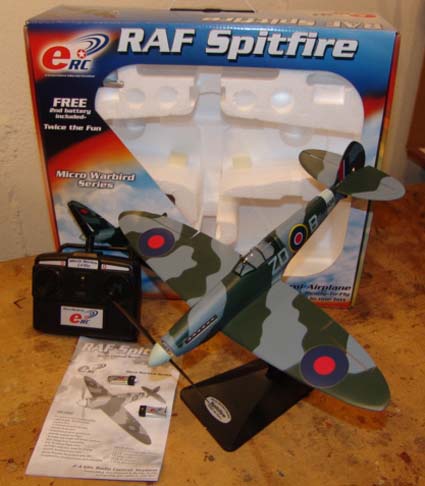
I first saw the prototype of the eRC Micro P-51D Mustang Ridge Runner III RTF fly at a Skymasters' meeting at the Ultimate Soccer Arenas. There was also the promotional literature there for the Spitfire. I liked the way the little P-51 flew and put the Spitfire on my "want list."
www.hobby-lobby.com/micro_raf_spitfire_rtf.htm
Just before the Toledo RC Expo, I noticed that Hobby Lobby had reduced the price to $59.99. I picked one up at Toledo for $50, and that was quite a good deal for this nice "micro" flier. It is truly ready to fly. It comes with the ready to fly plane, 2.4GHz transmitter, 2 single cell Li-Poly "batteries", 4 AA dry cells for the transmitter, a brief instruction manual, a warning NOT to use any type of charger except the one built into the transmitter (the polarity is different than other cells by other micro suppliers like E-flite) and a display stand. Everything needed to fly this little beauty is contained in a handy-dandy box with a carrying handle.
I really liked the fact that the first thing printed on the outside of the box under the specifications is a note that says "For Sport to Intermediate Pilots." While a beginner might think the Spitfire or its companion P-51 is a cute, little plane, it really is not for the low time pilot and Hobby Lobby puts that right up front. Good going guys!
Unfortunately the original plane had a bit of trouble after the first flight, it didn't "want" to make a second flight. Nothing I did. It just refused to work again. To Hobby Lobby's great credit, they quickly sent out a replacement and it has been a lot of fun to fly.
Several folks have flown it and noted that it is really fun, looks great in the air and is actually pretty darn tough for a little guy. From a gentle underhanded toss, at a bit more than "half" throttle, it flies away very easily.
Sitting on the display stand, it makes a nice addition to anyone's living room and a unique conversation piece. It becomes even more than a conversation piece when you take anyone asking about it down the street to the local little park with no trees and show them how well and long it flies on just a single cell.
It does fly in some wind, especially when flown by a person with at least intermediate skills. It is a bit quicker than you think it might be and has "gobs" of power. Of course it must be remembered that the plane with its single Li-Poly cell only weighs 27.3g/ 0.96 oz., so it is really for inside in a decent area like a high ceiling gym or outside with very good judgment on the wind conditions.
For all you get with the purchase of this little RTF, and for the fun factor of a "micro" flier, this eRC Micro Spitfire RTF is an excellent value. It is also a very nice display model to sit and admire and then return in your mind to the "Battle of Britain" when so few gave so much for so many.
Return to "What's In This Issue"
Hitec Optic 6 with Spectra 2.4GHz Module & Optima Series 6-channel & 7-channel Receivers
By Ken Myers
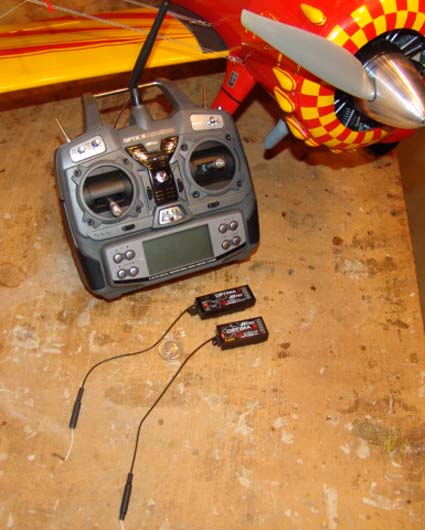
My Hitec Optic 6 2.4GHz Telemetric AFHSS (Adaptive Frequency Hopping Spread Spectrum) system was shipped from Tower Hobbies on December 28, 2009. It is not the latest version known as the Optic 6 Sport with the built-in 2.4GHz system. It came with the Hitec Spectra 2.4GHz module installed in the module aperture of the previous 72MHz version of the Optic 6 and two 7-channel Optima 2.4GHz receivers. I used a $25 promotional coded and also had free shipping. I had also ordered an X-Acto razor saw, which I needed, at the same time. The items were delivered for a total price of $178.98. The razor saw was $3.99; therefore the cost of the new transmitter and two 7-channel receivers was $174.99. Fly RC had a coupon for a free Optima 6-channel and a second one for $39.99 directly from Hitec. I sent in the coupon and my credit card number and in a few weeks the two new Optima 6-channel receivers arrived and my credit card was billed $39.99 with no shipping cost. For a total of $214.98 I am now into the 2.4GHz revolution with a new transmitter and four receivers.
If I need more receivers I can purchase them from Todd's Models (www.toddsmodels.com). The Optima 6-channel (14.1g measured) has a retail price of $69.95 but can be purchased for $46.99 and the Optima 7-channel (15.3g measured), with a retail price of $97.95, is $64.99 from Todd's Models. For comparison, Horizon Hobby offers their very popular Spektrum DSM2 AR6200 (10g mfg) 6-Channel Receiver Ultralite for $79.99 while Todd's sells it for $64.99 and the AR7000 (14g mfg) DSM2 7Ch Receiver is $99.99 from Horizon and $79.99 at Todd's Models.
At first I was not thrilled that I did not get the new version of the Optic 6, the Optic 6 Sport, with the 2.4GHz built in and a ten plane memory instead of the eight plane memory of the Optic 6. After a bit of learning and playing with my Hitec Optic 6, I changed my mind, and was very happy to have the older version. I realized that I can use the Spectra module in my trusty old Hitec Eclipse 7, if I choose to do so, and use the module from the Eclipse 7 in the Optic 6. While the Optic 6 Sport can store information for two more planes than the Optic 6, it does not have the dual timer. The dual timer is a very useful function, which I'll explain later.
I did not care for the instruction sheets that came with the Spectra module and Optima receivers. The directions they contained about linking were a bit vague to me and suffered from some "Chinglish/Koreanglish" and poor English grammar and spelling.
The two Optima 7-channel receivers came linked in 'Normal Mode' to the Spectra module. I wanted to link the two new 6-channel Optima receivers to the module and became confused when reading about the two linking options for either the 'Normal Mode' or the 'Scan Mode'. These two modes are available on all the Hitec 2.4GHz transmitters and modules. It is when the system is used in 'Scan Mode' that it becomes "adaptive." You can see how it adapts to the 2.4GHz frequencies in use in the videos listed later in the article.
Problem 1:
Hitec servos, switches and receiver batteries do not come with polarizing connectors like Futaba. The connector can be mated into the receiver receptacle in two ways. There is nothing on the receivers themselves that indicates polarity. The diagram shown in the instructions shows the connectors horizontally, while the slots in the receiver are vertical, so they are of no help when inserting the connectors into the receptacles in the receiver. This became a problem when I was initially setting up one of the 7-channel receivers in the Super Stearman.
I checked the Optic 6 manual to see if there was any helpful reference there and all it says is, "Be sure the alignment of the servo or battery connector is correct before inserting it into the receiver." Duh!
While setting up the Super Stearman, I found, by trial and error, that the negative (black or dark wire) goes away from the "top" of the receiver. I am defining the "top" of the receiver as the side with the main label and the 'Link' button.
I linked the two new receivers on the bench with the transmitter being at least 18" away from the receiver as stated in the instructions. I used a couple of servos, a switch harness and receiver battery for the linking process.
I followed the 'Linking(ID-setting) when Transmitter is in Normal Mode' procedure as outlined in the directions.
There was no problem following step 'a' of the ID-setting instructions. After holding down the 'Link' button on the module and then turning on the transmitter, the red LED was flashing. This showed that the module in the transmitter was searching for a receiver. Actually, receiver is probably an incorrect term, as the Optima receivers are really transceivers.
Next, following the step 'b' procedure, I pressed and held the 'Link' button on the receiver and turned the receiver on with the switch on the switch harness. I released the 'Link' button. Then I became confused. The instructions mentioned that the blue LED did something. On the first 6-channel receiver, I never saw the blue LED come on and when setting up the second receiver, I saw the blue LED blink for an instant. Both receivers appear to be linked now and function normally. The red LED is constantly displayed on the module and the receiver, showing a link in 'Normal Mode'. 'Scan Mode' is designated when both the red and blue LEDs are illuminated on the module and receiver. The LEDs are extremely visible compared to those found on the Spektrum receivers.
Setting the fail safe was very easy and went just as described in the instructions.
Overall I would say that linking the receiver and transmitter is much easier than reading the instructions to do it, and much easier than binding a Spektrum receiver, at least for me.
RC Model Reviews (www.rcmodelreviews.com) and (www.youtube.com/user/RCModelReviews#p/u) has a lot of very interesting information regarding 2.4GHz systems.
To see how Hitec's 2.4GHz system works view the following:
Part 1: www.youtube.com/watch?v=AdIhbNLC0yg
Part 2: www.youtube.com/watch?v=R6aNeZ-Dlio
Part 3: www.youtube.com/watch?v=7f43mydRdjA
You can compare the Hitec to the Spektrum/JR DSM-2 by viewing the following:
Part 1: www.youtube.com/watch?v=Vy7Gg6Tj57Q
Part 2: www.youtube.com/watch?v=bw1heqMyo9w
Don't miss this one either:
www.rcmodelreviews.com/dsm2flaw.shtml
I am somewhat familiar with Hitec programming because of my Eclipse 7 usage, but found the timer functions on the Optic 6 very confusing. A talk with a Hitec representative at Toledo this year cleared up that confusion, and now I think the dual timers on the Optic 6, not available on the Optic 6 Sport, are a very important asset, even worth giving up two plane set ups for! The Optic 6 manual that came with my system has it all wrong. Here is how the timers work.
Timer '1':
Timer '1' can be used as both a countdown timer from a preset number of minutes and a stopwatch/count-up timer. To use as a stopwatch, the number of minutes for the Timer is set to 0.
To start Timer '1' in either countdown or stopwatch function, the Data + (plus) or Data Š (minus) buttons must be pressed so that the indicator triangle is over the 1. A press of the Cursor right button starts and stops Timer '1'. A press of the Cursor left button clears the timer and resets it to the selected value. The Cursor left button can also stop and clear the timer, resetting it to the selected value. If a predetermined time was selected, say 6 minutes, then the transmitter starts beeping once a second when 10 seconds are left on the countdown timer. When the timer reaches 0 minutes, after 6 minutes in this example, the beeping stops and the timer display resets to the original display of 6 minutes.
Timer '2'
Timer '2' always starts whenever the throttle is activated whether the Timer '2' display is showing on the screen or not. It is always a stopwatch/count-up timer, and runs whenever the throttle is "opened" and stops when the throttle is "closed/off". The default setting of Timer '2' is 0 minutes so there is no beeping and its function may go unnoticed by the user. If the pilot wants to fly for 6 minutes of throttle "on" time, Timer '2' is programmed for 6 minutes, instead of the default 0 minutes. As noted earlier, Timer '2' does not need to be displayed, as the timer is ALWAYS activated by the throttle "on" movement and off when the throttle is "closed/off". The user needs to take no action to use Timer '2' other than setting the desired time. If the time was set for 6 minutes, then at 5 minutes and 50 seconds of elapsed time on the timer, the beeper starts. The beeper stops when the time reaches 6 minutes, in this case. The timer continues to count up as long as the throttle is "open". After landing, and with the throttle "off", the elapsed throttle "on" time can be noted when the Timer '2' screen is displayed using the Data + or Data - buttons.
This is very handy for two reasons. The pilot does not need to remember to do anything to activate the timer function. The total elapsed throttle "on" time can be used to estimate the average amp draw for electric fliers.
This type of timer can be very handy as it eliminates the need to remember to start the timer at the beginning of each flight. This "old man" really appreciates having one less thing to remember at the flying field!
Flying the Optic 6 2.4GHz System
I put a 7-ch Optima receiver in my old Flite 40, "40-size" sport plane, to test it. After a good range check, which is very easy to do with this system, I flew several successful flights on April 20. When I got home, I replaced the 7-ch that I'd used to set up my Super Stearman with the "tested" 7-ch and put the untested 7-ch receiver into the Flite 40. On April 22, after ranging checking both systems, I flew the Flite 40. Once again the connection between ground and air proved rock solid.
I now had enough "faith" in my new radio system to put the Super Stearman up for its maiden flight. The plane and radio system proved to be real winners.
I swapped the 7-ch out of the Flite 40 and installed one of the new 6-ch receivers. For some reason it had to be re-linked to the transmitter, even though I'd linked it earlier on the bench. It only took a couple of minutes to do it, and I didn't have to refer to the instructions to do it. I also set the failsafe without having to refer to the instructions.
The first 6-ch Optima was test flown on April 28 and the second one on May 6. Both performed without a hitch. The second 6-ch did not need to be linked, as I had already linked it during the bench test. I'm thinking that maybe I didn't link the first 6-ch on the bench and just thought that I had.
I am now satisfied that I've picked a pretty good 2.4GHz system, and I'm very happy that I've gone with Hitec. I can personally recommend it to folks who want to get into the 2.4GHz revolution without going Spektrum.
What I really like a lot:
Rock solid 2.4GHz operation
Throttle Lock
Timer activated by throttle
What I don't like so much:
1300mAh NiMH Tx battery instead of Sanyo Eneloop or similar Hybrid NiMH battery
No 'Model Match'
Return to "What's In This Issue"
Denny Sumner's Super Sportwin
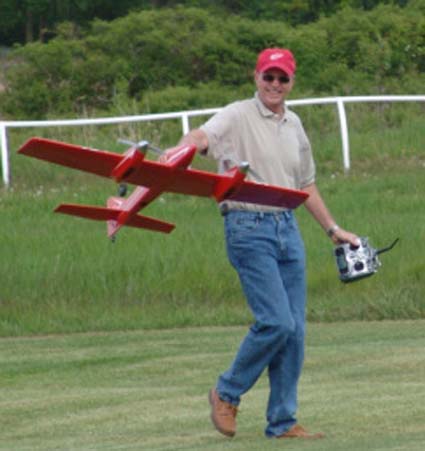
The big smile on Denny's face after the maiden says it all
Denny finally had a chance to maiden his Mark Rittinger designed Super Sportwin. Mark's design is an enlarged version of his famous Super Sportwin. This larger version also features retracts. Both Mark and Denny had their models entered in the Toledo RC Expo this year.
Mark had not yet finished up his plans when Denny cajoled him into a copy, so Denny's plane is really prototype 2 for Mark.
You'll find a lot more information and photos in the Super Sportwin thread on RC Groups.
www.rcgroups.com/forums/showthread.php?t=1075719
The maiden of Denny's plane on, the evening of May 20, was perfect. The plane looks great in the air and tracks very nicely. It is an extremely smooth flier and sounds fantastic with the twin motors.
Here are the specifications for Denny's plane.
Wing area: 450 sq.in.
Wing Span: 50 in.
2 Motors: Scorpion 3008-1090kv
2 ESCs: Scorpion 35 amp
Power Battery: 3S 5000mAh (25C) Zippy
Weight: 4 lbs 2 oz. (66 oz./1871g)
Props: APC 9x7.5E
Wing Cube Loading: 11.95 oz./cu.ft.
Wing Area Loading: 21.12 oz./sq.ft.
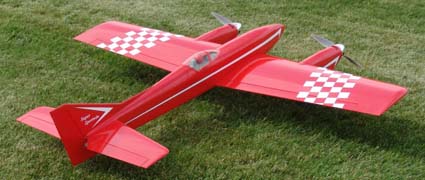 Return to "What's In This Issue"
Return to "What's In This Issue"
Ultimate Racing at the Ultimate Soccer Arenas
By Ken Myers additional information from Joe Hass
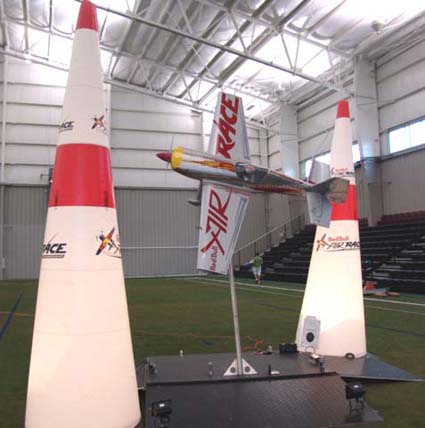
I was absolutely amazed upon arriving on the evening of May 25 at the Ultimate Soccer Arenas to find such a fantastic setup sponsored by Red Bull.
It was the first (of I hope many) "Ultimate Racing at Ultimate Soccer" events. It was a huge success. There was an estimated 150 spectators with 31 registered pilots flying in three categories for cash and prizes. The event was sponsored by the Red Bull Air Races, which were taking place on the Detroit River on June 5 & 6, 2010.
John Griffin, of Red Bull, had contacted the Skymasters to promote the upcoming full-size Red Bull Air Races.
The course required both a combination of speed and maneuverability; even so, REM type planes could still fly it. Unfortunately, I hadn't realized this when I decided to take my little eRC Spitfire. It was not the best choice, but I still had fun. IÕm not so sure about the fellow manning that stopwatch that I ran into at the finish line for a DNF! Luckily, there was no harm done to him or my less than one-ounce plane.
The Skymasters set up the course, hung the Reb Bull signs and assembled the Red Bull displays. A really cool Red Bull Photo Booth was set up where anyone could get a free photo of himself or herself that had been electronically inserted into a Red Bull plane cockpit. The types of aircraft flown included homebuilt wood machines, foamies and ARFs.
There were two rounds flown in each category, beginner, expert and advanced expert. The scores were averaged to determine the winners. Between rounds Mark Freeland of Retro RC, Bill Brown Sr. and Bill Brown Jr. flew antique aircraft (Demoiselle, Antoinette, etc.) in mock races with aircraft that fly slower than a slow walk.
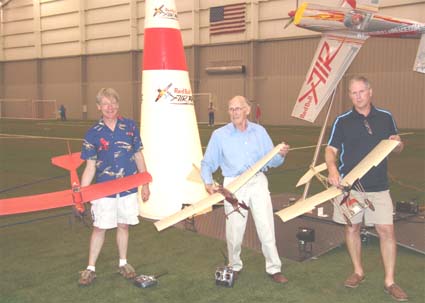
During the final score tabulations the ETOC (Electric Tournament of Champions) competitors Jamie Hicks and Chris Hass put on a synchronized freestyle flying routine that wowed the good sized crowd of spectators and pilots.
The first through third place winners in each category received a cash prize as well as additional hardware. The other competitors, like me, and spectators received a variety of hobby items in a random drawing. Four really lucky folks each got a pair of tickets to the actual Red Bull Races.
The event was possible because of the support of the Skymasters officers and members and the contributions of Castle Creations, Air Hobby, AirLandSeaHobby.com, the Academy of Model Aeronautics, Flight Line Hobby, Hobbico, Horizon Hobby, Prop Shop Hobbies, Red Bull, RJRCoolTools.com and the Ultimate Soccer Arenas.
Joe noted that work has already begun for another Ultimate Race next year. You should definitely plan on attending and flying at this one. I know IÕll have a more suitable plane and be there to give it a go once again. It's just way too much fun not to participate!
As Joe Hass yelled each time a plane came through the starting gates, "SMOKE ON!" I hope to see you there in 2011.
Return to "What's In This Issue"
Mark Wolf's WACO & Ken's Super Stearman
See 'em at the Mid-Am
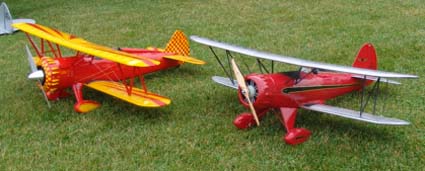
Return to "What's In This Issue"
| 







